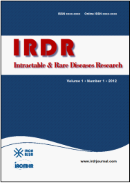BioScience Trends. 2017;11(5):259-266. (DOI: 10.5582/ddt.2017.01052)
Two-spotted cricket as an animal infection model of human pathogenic fungi.
Kochi Y, Matsumoto Y, Sekimizu K, Kaito C
Invertebrate infection models that can be evaluated at human body temperature are limited. In this study, we utilized the two-spotted cricket, a heat-tolerant insect, as an animal infection model of human pathogenic fungi. Injection of human pathogenic fungi, including Candida albicans, Candida glabrata, and Cryptococcus neoformans killed crickets within 48 h at both 27?C and 37?C. The median lethal dose values (LD50 values) of C. albicans and C. glabrata against crickets were decreased at 37?C compared to that at 27?C, whereas the LD50 value of C. neoformans was not different between 27?C and 37?C. Heat-killed cells of the three different fungi also killed crickets, but the LD50 value of the heat-killed cells was higher than 5-fold that of live fungal cells in the respective species. C. neoformans gene-knockout strains of cna1, gpa1, and pka1, which are required for virulence in mammals, had greater LD50 values than the parent strain in crickets. These findings suggest that the two-spotted cricket is a valuable infection model of human pathogenic fungi that can be used to evaluate fungal virulence at variable temperatures, including 37?C, and that the killing abilities of C. albicans and C. glabrata against animals are increased at 37?C.







